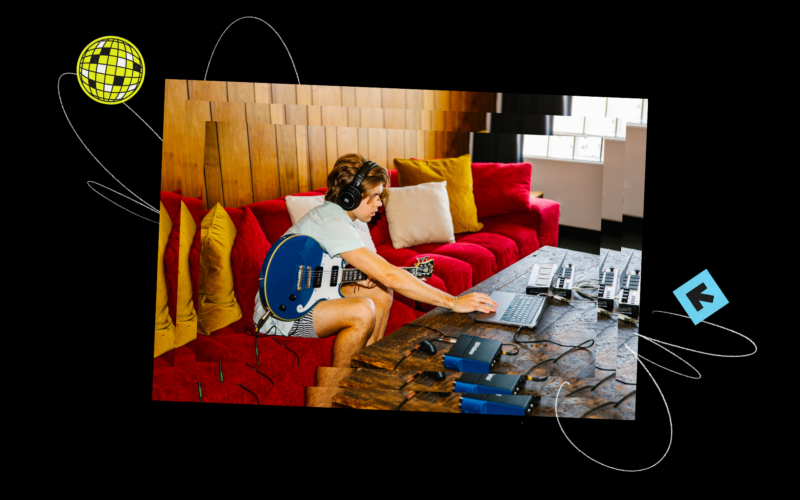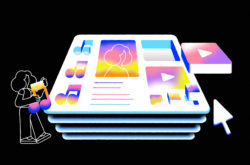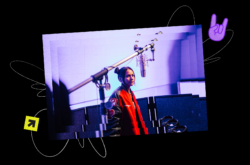Are you planning to apply to a music-focused program?
Are you interested in organizing the best representation of your music for your application? Do you want to find a publisher or future collaborator? If your answer to any of these questions is “yes,” you may want to assemble your first music portfolio.
What is a music portfolio?
A music portfolio showcases your songs, productions, performances, potential, and personality. A well-structured portfolio can be a key tool for communicating your talents, attracting opportunities, and leaving a lasting impression on potential collaborators and clients.
Having a music portfolio helps you:
- Give a great first impression: Your portfolio is often people’s first interaction with your work. It’s a chance to make a solid first impression and capture the essence of your musical style.
- Showcase your range: A well-constructed portfolio demonstrates your versatility as an artist. It allows you to showcase different genres, moods, and skills that you excel in.
- Demonstrate professionalism: A polished portfolio demonstrates professionalism and dedication to your craft. It’s a mark of credibility for potential schools and other opportunities.
- Build your network and find opportunities: Your portfolio can attract collaborations, gigs, licensing deals, and other opportunities that align with your musical goals.
How do you create a good music portfolio? In my experience, the following eight steps will help you craft a compelling portfolio.
1. Get started now
Sometimes, we let self-criticism get in the way of us moving forward in music.
However, it’s better to start your portfolio with your current work rather than waiting for the perfect song or performance.
Including your current work will speed up the process and allow you to have a portfolio ready for an imminent deadline, like a college application—you can use your music portfolio as a goal to motivate yourself to start or finish a new project. That said, don’t disregard older work that might be already available or forgotten somewhere on your hard drive either.
2. Create a music portfolio that best represents you
It’s essential to have a vision of what kind of musician you want to be, and that image should be expressed in your portfolio. You don’t need to copy or emulate somebody else’s artistic vision; be true to yourself.
You may be a jack-of-all-trades or specialize in one area of music like performance or engineering. Whatever your focus, make sure your portfolio reflects you and what you’re most passionate about.
3. Learn how to select your best work
The cornerstone of the portfolio is the music you choose to showcase. Here are some considerations that may help you make the right selections:
- Quality over quantity: Prioritize quality tracks over quantity. A few exceptional pieces are more impactful than an extensive collection of mediocre ones.
- Variety: Include tracks highlighting styles, moods, and technical skills to showcase your adaptability and range.
- Progression: If possible, arrange your tracks to demonstrate your growth as an artist.
4. Use audio and video assets
Your music portfolio isn’t just made by the music itself. Visual assets can also be used to enhance the overall experience:
- Cover art: Acquire or design eye-catching cover art for each track. This adds a professional touch and gives listeners a visual representation of your music.
- High-quality audio: Ensure your audio files are of the highest quality. Use lossless formats like .wav or FLAC to preserve the integrity of your music.
- Reel: Create a small compilation of your work and present it in a short edit that includes all of them.
5. Create a page or a website for your music portfolio
A dedicated website for your music portfolio provides a centralized platform for your audience to explore your work. Here are some tips for setting up your own website:
- The domain: Select a domain name that’s easy to remember and relevant to your name or musical identity.
- User-friendly layout: Design a clean, intuitive layout that allows visitors to navigate effortlessly. Consider using website builders or templates if you’re not a web design expert.
- Track descriptions: Write brief descriptions for each track, offering insights into the inspiration, production process, and any unique elements.
- Alternatives: You also have several other options for uploading and sharing your music portfolio online, depending on your goals and preferences.
Some popular platforms and websites where you can showcase your music are:
- SoundCloud: SoundCloud is a popular platform for independent musicians to upload and share their music. It allows you to create a profile, upload tracks, and connect with a community of music enthusiasts.
- YouTube: Create a channel for your music, sharing videos and audio tracks with visuals to reach a wide audience.
- Bandcamp: Upload your music, set pricing, and sell merchandise on this artist-friendly platform.
- Spotify / Apple Music for Artists: Use these services to upload music, manage profiles, and access analytics for streaming platforms.
- SoundClick: Connect with fans and share your music on this social music community platform.
- ReverbNation: Utilize tools for uploading, profiling, and promoting your music.
- Social media: Share music snippets and engage with your audience on platforms like Instagram, Facebook, Twitter, and TikTok.
- Online music communities: Collaborate and get feedback from peers by joining music forums and communities.
6. Prepare a professional bio
Introduce yourself to your audience and potential collaborators through a well-crafted bio. Here are some tips:
- Compelling biography: Write a bio that captures your musical essence and goals, and gives a glimpse into who you are.
- Contact details: Make it easy for people to reach you—include a professional email addresses, social media links, and other relevant contact information.
7. Showcase collaborations and projects
If you’ve collaborated with other artists and producers or worked on specific projects, highlight them:
- Collaborator credits: Mention the roles of your collaborators and provide links to their portfolios and social media as well.
- Project details: Describe the project’s circumstances—this gives context for your role in the collaboration.
8. Make regular updates
A stagnant portfolio can give the impression of an inactive artist. Keep your music portfolio fresh and engaging:
- Latest releases: Update your portfolio with new tracks as you release them.
- News and achievements: Share any significant milestones, awards, or recognition you’ve received.
How to prepare your music portfolio: Final thoughts
Remember, your portfolio reflects who you are as an artist, so take the time to curate it thoughtfully to present your music authentically to the world.
Crafting a music portfolio requires careful thought and attention to detail, but the rewards are worth the effort. It’s a dynamic representation of your artistic journey and a powerful tool for attracting opportunities that align with your musical aspirations.
College students, educators, and other Splice users who register using a valid .edu email address are now eligible for a discounted monthly price on our Sounds+ plan:
September 12, 2023



